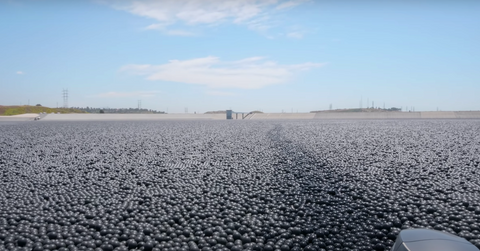Shade Balls Are Meant to Conserve Water — but They Also Pose a Few Problems
Published July 15 2021, 5:29 p.m. ET
If you were to look at a photograph of a certain reservoir in Los Angeles, California, you might catch a glimpse of what looks like thousands of black spheres floating on its surface. These are shade balls, which are innovative orbs used to conserve water in places that are most prone to droughts.
Water conservation was not shade balls' original purpose, however — their initial use was far more specialized. Still, as effective as shade balls might be, they do possess some problematic elements in both their construction and their design.
What are shade balls?
Shade balls are made from high-density polyethylene, otherwise known as plastic. They are black, typically about 10 inches in diameter, and designed to reduce evaporation by 80 or 90 percent by providing shade from the sun, though that wasn’t always their purpose, according to the Toronto Star. Their original purpose was to keep birds away from toxic tailing ponds near mining sites. After that, airport workers used them to keep birds away from airport runways by covering nearby ponds and rivers.
Back then, the balls were known as bird balls. It wasn’t until 2008 that they were used for another purpose. Officials released a slew of the newly-coined shade balls into the Idaho reservoir in order to combat a natural and highly toxic chemical reaction that occurs when sunlight hits bromide and chlorine.
After that, they found a new purpose as a means to conserve water in drought-prone places like Los Angeles. Amanda Parsons, a spokesperson for Los Angeles Department of Water and Power, told the Toronto Sun that the balls did this by “reducing the water surface area exposed to the sun.”
How are shade balls helpful?
The balls have been successful in both reducing the creation of toxic bromate and reducing algae growth in public reservoirs. The balls were similarly effective as a means for keeping birds away from bodies of water. As for slowing evaporation, there are still some kinks to work out. According to PBS, LA officials assert that the balls will save up to 300 million gallons of water annually, which is enough to supply drinking water to 8,100 people.
However, scientists argue that the balls would need to sit on top of the reservoir for a year or more in order to have any noticeable effect. At this point, the shade balls have been on the reservoir since 2015, so they are probably saving more water than it took them to produce in the first place.
Are shade balls dangerous?
Of the many cons associated with shade balls, the fact that they are made from plastic is perhaps the most egregious. According to PBS, the process for making polyethylene balls is just as water-intensive as any other form of plastic manufacturing. This process also involves the use of oil, natural, gas, and electricity, which all contribute to greenhouse gas emissions. Those emissions warm the planet, causing a greater risk of evaporation, thereby creating a greater need for the balls.
According to Discard Studies, there is also a chance that BPA chemicals from shade balls could be leaching into the waters of the reservoir. Typically found in plastic, BPA is an endocrine disruptor that usually breaks down in water after a few weeks or months. These balls have been sitting on the reservoir in the hot sun for more than half a decade now, and though we don’t know exactly what chemicals are present in the plastic balls, it's likely that they are not BPA-free.
In the end, it seems as though shade balls have been removed from all but one of LA’s reservoirs. According to Governing, this removal was mostly due to the cost-prohibitive nature of the shade balls project, not the environmental or health concerns surrounding their usage. It remains to be seen what long-term effects the balls will continue to have on the quality of LA’s drinking water.
